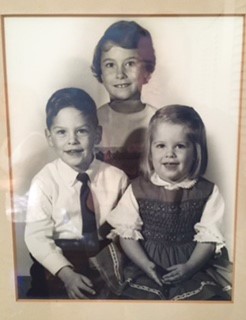
When I was a kid, shoe stores were privately owned small businesses with names like Matthew’s and David’s. There were no mega shoe stores with boxes displayed within customer reach. Back then, you picked a shoe and asked the clerk, who you probably knew by first name, to get it in your size, and then he spent the time to make sure the fit was right.
My mother took the shoe buying experience serious; she expected the salesperson to measure our foot on the metal measuring device, press the end of the toe to make sure we had enough growing room, feel the sides to check the width and watch us walk down the catwalk, to the end of the store and back. She wanted the best for us, and thankfully she could afford it.
Today, personal, hands-on experience can be hard to come by. In most instances, salespeople are merely employees who will run to a back room and grab you the right size. Their knowledge is limited and we consumers don’t seem to mind because we want our shoes fast; without hassle. In the end, I fear we have swapped experience and knowledge for personal convenience, and our feet are paying the price.
Buying blind!
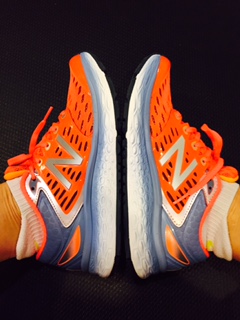 Picking out a pair of sneakers is a bigger decision than you think; they have to provide proper support for the rigors of exercise. I’ve have exercised daily for over 30 years, and I was always looking for a good sneaker at a good price. I frequented mega stores, factory outlets, and franchised shops, retrieving only small amounts of information about cushioning and gel absorption features. I was buying blind forgetting the uniqueness of my foot.
Picking out a pair of sneakers is a bigger decision than you think; they have to provide proper support for the rigors of exercise. I’ve have exercised daily for over 30 years, and I was always looking for a good sneaker at a good price. I frequented mega stores, factory outlets, and franchised shops, retrieving only small amounts of information about cushioning and gel absorption features. I was buying blind forgetting the uniqueness of my foot.
The intricacy of my foot.
When I started to have issues with my big toes, almost feeling like they were sprained, and experiencing shooting pain and soreness on the side of my foot, I finally decided to go to a foot and ankle specialist. Just making that decision took me over six months. It took me way too long to I realize that store bought inserts, bunion gel cushions, and ball of the foot pads were not going to heal me.
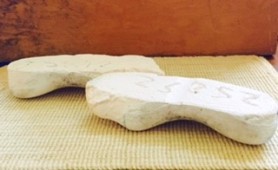
The doctor pointed out that my high arches and lack of proper support (even though I replaced my original inserts with high arch support inserts) were causing the main nerve running down through my big toe to be compromised. He suggested orthotics which I thought were for old people; silly me. I had molds made of my feet that day, and after a few months I could exercise again, pain free.
Time to buy.
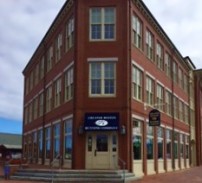
Once my orthotics were broken in, it was time for new sneakers. I had heard about specialty stores that had treadmills with video equipment that were all the rage in terms of buying the right shoe, but I had never been to one. After spending the money on orthotics, I decided I wasn’t messing around with mega stores anymore; no more wasting money on the wrong shoe. I found a store that could give me the attention my poor feet needed; The Greater Boston Running Company.
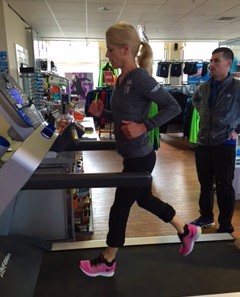
When I walked into The Greater Boston Running Company, Pat and Matt, both runners, greeted me and my husband. I told them about my exercise routine, my orthotics and my desire to get the right shoe. We discussed aches and pains, injuries, and more about my training style. “I run three times a week, about five miles each time, and on off days I use an elliptical, punching bag, and jump rope. I need a sneaker, or sneakers to handle my cross training as well as running workouts,” I said. They put me on the treadmill and videoed my stride, technically assessing alignment and foot strike; ‘gait analysis’.
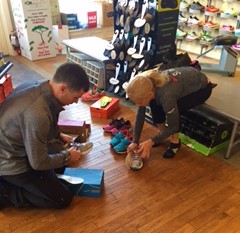
When the time came to pull some shoes off the shelf, they took into account my high arch, wide foot, and alignment from hips to knees and down through the ankle and foot. They encouraged me to buy at least a half size bigger if not more, because the foot swells during exercise. They laced the sneaker, put my orthotic in, and checked the fit – like the old days. We discussed a stiffer vs. more flexible style, deciphering what was best for me.
As trained professionals who keep up with current trends by attending clinics and conversing at length with sneaker reps, they were technically experienced and ready to fit me with the best shoe for my body and training style. They could also supply me with shoes that were technologically up-to-date, meaning they weren’t seconds or older models, as you might find in warehouse or outlet stores.
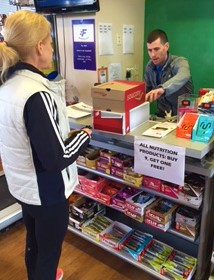
As experienced runners, a pre-requisite to work in the store, they genuinely cared about my experience in their store; they had been in ‘my shoes’ in the past, buying sneakers in their youth that were not up to par. They didn’t push high price models; I actually bought two pairs on sale, with prices comparable to mega stores. There was no pitch and no pressure; just their full attention. I left satisfied and still am months later.
GBRC not only sells to runners. I asked Pat if someone who was a walker would jump on the treadmill to be assessed, “It’s not necessary because we can have them walk for us to check their stride,” he responded. Running shoes are perfect for the ‘walker’ because, “The pressure a runner feels is 3 1/2 to 5 times their body weight with each stride, while a walker feels 1 1/2 times their body weight per stride. A more cushioned sneaker will give the walker a more comfortable experience,” Pat told me.
So, what’s your foot type?
Paying attention to the type of foot structure you have is crucial. Getting an orthotic, if you need one is the first step, buying the right sneaker is the second. Do you have a high arch, flat feet, normal foot structure? Do you suffer from bunions, shin splints, or knee pain? Determining whether your foot rolls inward or outward when you walk or run can be ‘the’ crucial factor in deciding on a stiffer or more flexible shoe. Check out Runners World link below for more information on foot type. (1)
Personally, I was thrilled to get on the treadmill because I could see how my stride looked. Pat noticed immediately that my right calf and foot were turning outward just as my foot hit the treadmill. We discussed possible reasons; over compensation for left leg issues such as partial ACL tear, hamstring and groin pull, prior meniscus issues. At least now I could see what I was doing because of the video and could try to alter my stride. Check out my assessment video on YouTube, https://www.youtube.com/channel/UCeMdPQKvMLaMzcg1SXn2fJw
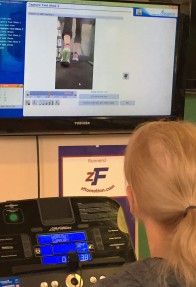 I could see, by running the video in slow and stop motion, the line they were looking at from the sole of my foot up through my fibula, was straight; the orthotics were working correctly. From that point, I tried on four pairs of sneakers and ran on the treadmill to try each pair out. Comfort and flexibility helped me make my final decision; color and cost did not factor in.
I could see, by running the video in slow and stop motion, the line they were looking at from the sole of my foot up through my fibula, was straight; the orthotics were working correctly. From that point, I tried on four pairs of sneakers and ran on the treadmill to try each pair out. Comfort and flexibility helped me make my final decision; color and cost did not factor in.
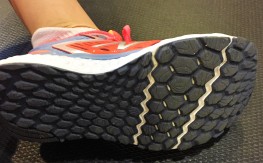
I ended up with New Balance 1080 for running on the treadmill; it incorporates a flexible sole with a wider toe area, perfect for my duck feet, and Saucony Triumph Iso for cross training; a flexible sneaker with attached tongue that felt like putting on a slipper. Both shoes are extremely light in weight as well.
Questions?
How do you know when your sneakers are spent?
To help prevent injury to joints and muscles, replace sneakers every 300 to 400 miles. If you run on a treadmill your shoes may make it the 400-mile mark. Try rotating a new pair in halfway through the life of the shoe; notice subtle changes in cushioning from the first to second pair.
How can I make my sneakers last longer?
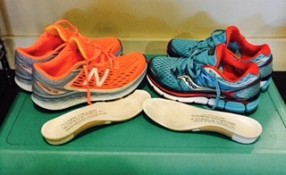
-If you run daily, rotating two pairs of sneakers is smart; giving shoes a day of rest to air out is a good thing; it helps prevent injury and could curtail athletes foot. Start a new pair one month into the first pairs life.
-Store sneakers in a cool, dry place. If they get wet, stuff with newspaper or paper towel to absorb moisture. Baking soda, dryer sheets, and sneaker balls can be used to remove odor.
-Don’t rip those puppies off without untying them; sounds silly but you are unnecessarily stressing the shoe and compromising its performance.
-Only use your running sneakers for running – don’t casually walk around in them. You are depleting the cushioning each time you wear them. (2)
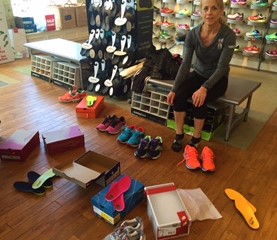
If you are more interested in your overall health, if you’re ready to take the time to speak to a knowledgeable salesperson, if comfort and buying the right sneaker to get the job done trump color and cost, and if you want that neighborhood feel in a shoe buying experience – then go to a specialty shoe store that offers you high quality products with high quality service, like GBRC. Remember, you don’t have to be a marathoner to qualify for a great pair of running shoes!
*Check out, https://www.jackrabbit.com/info/locations/, for sister stores to GBRC located across the country, or search, Greater Boston Running Company, for a list of Massachusett locations.
References:
(1) http://www.runnersworld.co.uk/shoes/choosing-a-shoe-the-very-basics/481.html
(2) http://running.about.com/od/shoesapparelandgear/a/foottypes.htm
YouTube video: https://www.youtube.com/channel/UCeMdPQKvMLaMzcg1SXn2fJw
Great information, thanks Kathy! Over-pronater here, so I have to wear shoes with stabilizers. Ive been thru my share of trial by error, wasted money, and injuries. It really does make a big difference when you get the right running shoe for your feet.
LikeLike
Thanks for reading Tammy!
LikeLike